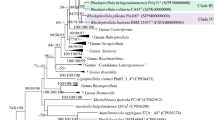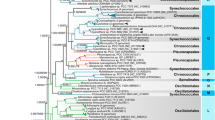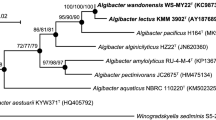Abstract
The Aquificales are prevalent members of the microbial communities inhabiting many marine and terrestrial hydrothermal systems. Numerous new strains were obtained from deep-sea and terrestrial hydrothermal systems. In order to resolve the phylogenetic relationships within this group, three different phylogenetic datasets were used, namely the 16S rRNA gene, the intergenic transcribed spacer region between the 16S rRNA and 23S rRNA genes (ITS) and the gene coding for the ATP citrate lyase (aclB), a key enzyme in the reductive TCA cycle. The data were analyzed using neighbor-joining, parsimony and maximum likelihood. The resulting phylogenies appeared to be consistent between the three markers. The three genes confirmed the presence of isolates that merit further characterization and descriptions as new species and perhaps even new genera. The detailed phylogenetic interrelationships of these isolates are described here.

Similar content being viewed by others
References
Aakra A, Utaker JB, Pommerening-Roser A, Koops HP, Nes IF (2001) Detailed phylogeny of ammonia-oxidizing bacteria determined by rDNA sequences and DNA homology values. Int J Syst Evol Microbiol 51:2021–2030
Aguiar P, Beveridge TJ, Reysenbach AL (2004) Sulfurihydrogenibium azorense, sp. nov., a thermophilic hydrogen-oxidizing microaerophile from terrestrial hot springs in the Azores. Int J Syst Evol Microbiol 54:33–39
Altschul SF, Madden TL, Schaffer AA, Zhang J, Zhang Z, Miller W, Lipman DJ (1997) Gapped BLAST and PSI-BLAST: a new generation of protein database search programs. Nucleic Acids Res 25:3389–3402
Beh M, Strauss G, Huber R, Stetter KO, Fuchs G (1993) Enzymes of the reductive citric acid cycle in the autotrophic eubacterium Aquifex pyrophilus and in the archaebacterium Thermoproteus neutrophilus. Arch Microbiol 160:306–311
Blank CE, Cady SL, Pace NR (2002) Microbial composition of near-boiling silica-depositing thermal springs throughout Yellowstone National Park. Appl Environ Microbiol 68:5123–5135
Bocchetta M, Gribaldo S, Sanangelantoni A, Cammarano P (2000) Phylogenetic depth of the bacterial genera Aquifex and Thermotoga inferred from analysis of ribosomal protein, elongation factor, and RNA polymerase subunit sequences. J Mol Evol 50:366–380
Burggraf S, Olsen GJ, Stetter KO, Woese CR (1992) A phylogenetic analysis of Aquifex pyrophilus. Syst Appl Microbiol 15:352–356
Campbell BJ, Cary SC (2004) Abundance of reverse tricarboxylic acid cycle genes in free-living microorganisms at deep-sea hydrothermal vents. Appl Environ Microbiol 70:6282–6289
Campbell BJ, Stein JL, Cary SC (2003) Evidence of chemolithoautotrophy in the bacterial community associated with Alvinella pompejana, a hydrothermal vent polychaete. Appl Environ Microbiol 69:5070–5078
Cherif A, Borin S, Rizzi A, Ouzari H, Boudabous A, Daffonchio D (2003) Bacillus anthracis diverges from related clades of the Bacillus cereus group in 16S–23S ribosomal DNA intergenic transcribed spacers containing tRNA genes. Appl Environ Microbiol 69:33–40
Cho JC, Tiedje JM (2000) Biogeography and degree of endemicity of fluorescent Pseudomonas strains in soil. Appl Environ Microbiol 66:5448–5456
Daffonchio D, Cherif A, Brusetti L, Rizzi A, Mora D, Boudabous A, Borin S (2003) Nature of polymorphisms in 16S–23S rRNA gene intergenic transcribed spacer fingerprinting of Bacillus and related genera. Appl Environ Microbiol 69:5128–5137
Deckert G, Warren PV, Gaasterland T et al (1998) The complete genome of the hyperthermophilic bacterium Aquifex aeolicus. Nature 392:353–358
Eder W, Huber R (2002) New isolates and physiological properties of the Aquificales and description of Thermocrinis albus sp. nov. Extremophiles 6:309–318
Ferris MJ, Kuhl M, Wieland A, Ward DM (2003) Cyanobacterial ecotypes in different optical microenvironments of a 68 degrees C hot spring mat community revealed by 16S–23S rRNA internal transcribed spacer region variation. Appl Environ Microbiol 69:2893–2898
García-Martínez J, Acinas SG, Anton AI, Rodríguez-Valera F (1999) Use of the 16S–23S ribosomal genes spacer region in studies of prokaryotic diversity. J Microbiol Methods 36:55–64
Götz D, Banta A, Beveridge TJ, Rushdi AI, Simoneit BR, Reysenbach AL (2002) Persephonella marina gen. nov., sp. nov. and Persephonella guaymasensis sp. nov., two novel, thermophilic, hydrogen-oxidizing microaerophiles from deep-sea hydrothermal vents. Int J Syst Evol Microbiol 52:1349–1359
Griffiths E, Gupta RS (2004) Signature sequences in diverse proteins provide evidence for the late divergence of the Order Aquificales. Int Microbiol 7:41–52
Griffiths E, Gupta RS (2006) Molecular signatures in protein sequences that are characteristics of the phylum Aquificae. Int J Syst Evol Microbiol 56:99–107
Gurtler V, Stanisich VA (1996) New approaches to typing and identification of bacteria using the 16S–23S rDNA spacer. Microbiology 142:3–16
Heyer J, Galchenko VF, Dunfield PF (2002) Molecular phylogeny of type II methane-oxidizing bacteria isolated from various environments. Microbiology 148:2831–2846
Huber R, Wilharm T, Huber D et al (1992) Aquifex pyrophilus gen. nov. sp. nov., represents a novel group of marine hyperthermophilic hydrogen-oxidizing bacteria. Syst Appl Microbiol 15:340–351
Huber R, Eder W, Heldwein S, Wanner G, Huber H, Rachel R, Stetter KO (1998) Thermocrinis ruber gen. nov., sp. nov., a pink-filament-forming hyperthermophilic bacterium isolated from Yellowstone National Park. Appl Environ Microbiol 64:3576–3583
Huber H, Diller S, Horn C, Rachel R (2002) Thermovibrio ruber gen. nov., sp. nov., an extremely thermophilic, chemolithoautotrophic, nitrate-reducing bacterium that forms a deep branch within the phylum Aquificae. Int J Syst Evol Microbiol 52:1859–1865
Hughes JB, Bohannan BJM, Brown JH, Colwell R, Fuhrman J, Green J, Horner-Devine MC, Kane M, Krumins JA, Kuske C, Morin O, Naeem S, Øvreas L, Reysenbach AL, Smith V, Staley J (2006) Microbial biogeography: putting microbes on the map. Nat Rev Microbiol 4:107–112
Janse I, Kardinaal WE, Meima M, Fastner J, Visser PM, Zwart G (2004) Toxic and nontoxic microcystis colonies in natural populations can be differentiated on the basis of rRNA gene internal transcribed spacer diversity. Appl Environ Microbiol 70:3979–3987
Kawasumi T, Igarashi Y, Kodama T, Minoda Y (1984) Hydrogenobacter thermophilus gen. nov., sp. nov., an extremely thermophilic, aerobic, hydrogen-oxidizing bacterium. Int J Syst Bacteriol 34:5–10
Klein M, Friedrich M, Roger AJ, Hugenholtz P, Fishbain S, Abicht H, Blackall LL, Stahl DA, Wagner M (2001) Multiple lateral transfers of dissimilatory sulfite reductase genes between major lineages of sulfate-reducing prokaryotes. J Bacteriol 183:6028–6035
Konstantinidis KT, Tiedje JM (2005) Genomic insights that advance the species definition for prokaryotes. Proc Natl Acad Sci USA 102:2567–2572
Kristjansson JK, Ingason A, Alfredsson GA (1985) Isolation of thermophilic obligately autotrophic hydrogen-oxidizing bacteria, similar to Hydrogenobacter thermophilus from Icelandic hot springs. Arch Microbiol 140:321–325
Kryukov VR, Saveleva ND, Pusheva MA (1983) Calderobacterium hydrogenophilum, nov. gen., nov. sp., an extremely thermophilic hydrogen bacterium and its hydrogenase activity. Mikrobiologiya 52:781–788 (in Russian)
Kwon SW, Park JY, Kim JS, Kang JW, Cho YH, Lim CK, Parker MA, Lee GB (2005) Phylogenetic analysis of the genera Bradyrhizobium, Mesorhizobium, Rhizobium and Sinorhizobium on the basis of 16S rRNA gene and internally transcribed spacer region sequences. Int J Syst Evol Microbiol 55:263–270
L’Haridon S, Cilia V, Messner P, Raguenes G, Gambacorta A, Sleytr UB, Prieur D, Jeanthon C (1998) Desulfurobacterium thermolithotrophum gen. nov., sp. nov., a novel autotrophic, sulphur-reducing bacterium isolated from a deep-sea hydrothermal vent. Int J Syst Bacteriol 48:701–711
L’Haridon S, Reysenbach AL, Tindall BJ, Schönheit P, Banta A, Johnsen U, Schumann P, Gambacorta A, Stackebrandt E, Jeanthon C (2006) Desulfurobacterium atlanticum sp. nov., Desulfurobacterium pacificum sp. nov., and Thermovibrio guaymasensis sp. nov., three thermophilic members of the Desulfurobacteriaceae fam. nov., a deep branching lineage within the Bacteria. Int J Syst Evol Microbiol (in press)
Ludwig W, Strunk O, Klugbauer S, Klugbauer N, Weizenegger M, Neumaier J, Bachleitner M, Schleifer KH (1998) Bacterial phylogeny based on comparative sequence analysis. Electrophoresis 19:554–568
Nakagawa S, Takai K, Horikoshi K, Sako Y (2003) Persephonella hydrogeniphila sp. nov., a novel thermophilic, hydrogen-oxidizing bacterium from a deep-sea hydrothermal vent chimney. Int J Syst Evol Microbiol 53:863–869
Nakagawa S, Nakamura S, Inagaki F, Takai K, Shirai N, Sako Y (2004) Hydrogenivirga caldilitoris gen. nov., sp. nov., a novel extremely thermophilic, hydrogen- and sulfur-oxidizing bacterium from a coastal hydrothermal field. Int J Syst Evol Microbiol 54:2079–2084
Nakagawa S, Shtaih Z, Banta A, Beveridge TJ, Sako Y, Reysenbach AL (2005) Sulfurihydrogenibium yellowstonense sp. nov., an extremely thermophilic, facultatively heterotrophic, sulfur-oxidizing bacterium from Yellowstone National Park, and emended descriptions of the genus Sulfurihydrogenibium, Sulfurihydrogenibium subterraneum and Sulfurihydrogenibium azorense. Int J Syst Evol Microbiol 55:2263–2268
Nishihara H, Igarashi Y, Kodama T (1990) A new isolate of Hydrogenobacter, an obligately chemolithotrophic, thermophilic, halophilic and aerobic hydrogen-oxidizing bacterium from seaside saline hot spring. Arch Microbiol 153:294–298
Noller HF (1984) Structure of ribosomal RNA. Annu Rev Biochem 53:119–162
Papke RT, Ramsing NB, Bateson MM, Ward DM (2003) Geographical isolation in hot spring cyanobacteria. Environ Microbiol 5:650–659
Pitulle C, Yang Y, Marchiani M, Moore ERB, Siefert JL, Aragno M, Jurtshuk P, Fox GE (1994) Phylogenetic position of the genus Hydrogenobacter. Int J Syst Bacteriol 44:620–626
Purkhold U, Pommerening-Roser A, Juretschko S, Schmid MC, Koops HP, Wagner M (2000) Phylogeny of all recognized species of ammonia oxidizers based on comparative 16S rRNA and amoA sequence analysis: implications for molecular diversity surveys. Appl Environ Microbiol 66:5368–5382
Reysenbach AL, Banta A, Boone DR, Cary SC, Luther GW (2000a) Microbial essentials at hydrothermal vents. Nature 404:835–836
Reysenbach AL, Ehringer M, Hershberger K (2000b) Microbial diversity at 83°C in Calcite Springs, Yellowstone National Park: another environment where Aquificales and ‘Korarchaeota’ coexist. Extremophiles 4:61–67
Reysenbach AL, Götz D, Banta A, Jeanthon C, Fouquet Y (2002) Expanding the distribution of the Aquificales to the deep-sea vents on Mid-Atlantic Ridge and Central Indian Ridge. Cah Biol Mar 43:425–428
Reysenbach AL, Banta A, Civello S, Daly J, Mitchel K, Lalonde S, Konhauser K, Rodman A, Rustenholtz K, Takacs-Vesbach C (2005) The Aquificales of Yellowstone National Park. In: Inskeep WP, McDermott TR (eds) Geothermal biology and geochemistry in Yellowstone National Park: workshop proceedings from The Thermal Biology Institute’s. Yellowstone National Park conference, October 2003. Montana State University, Bozeman
Rocap G, Distel DL, Waterbury JB, Chisholm SW (2002) Resolution of Prochlorococcus and Synechococcus ecotypes by using 16S–23S ribosomal DNA internal transcribed spacer sequences. Appl Environ Microbiol 68:1180–1191
Shiba H, Kawasumi T, Igarashi Y, Kodama T, Minoda Y (1985) The CO2 assimilation via the reductive tricarboxylic acid cycle in an obligately autotrophic, aerobic hydrogen-oxidizing bacterium, Hydrogenobacter thermophilus. Arch Microbiol 141:198–203
Shima S, Suzuki KI (1993) Hydrogenobacter acidophilus sp. nov., a thermoacidophilic, aerobic, hydrogen-oxidizing bacterium requiring elemental sulfur for growth. Int J Syst Bacteriol 43:703–708
Skirnisdottir S, Hreggvidsson GO, Hjörleifsdottir S, Marteinsson VT, Petursdottir SK, Holst O, Kristjansson J (2000) Influence of sulfide and temperature on species composition and community structure of hot spring microbial mats. Appl Environ Microbiol 66:2835–2841
Spear JR, Walker JJ, McCollom TM, Pace NR (2005) Hydrogen and bioenergetics in the Yellowstone geothermal ecosystem. Proc Natl Acad Sci USA 102:2555–2560
Stöhr R, Waberski A, Völker H, Tindall BJ, Thomm M (2001) Hydrogenothermus marinus gen. nov., sp. nov., a novel thermophilic hydrogen-oxidizing bacterium, recognition of Calderobacterium hydrogenophilum as a member of the genus Hydrogenobacter and proposal of the reclassification of Hydrogenobacter acidophilus as Hydrogenobaculum acidophilum gen. nov., comb. nov., in the phylum ‘Hydrogenobacter/Aquifex’. Int J Syst Evol Microbiol 51:1853–1862
Takacs CD, Ehringer M, Favre R, Cermola M, Eggertsson G, Palsdottir A, Reysenbach AL (2001) Phylogenetic characterization of the blue filamentous bacterial community from an Icelandic geothermal spring. FEMS Microbiol Ecol 35:123–128
Takai K, Komatsu T, Horikoshi K (2001) Hydrogenobacter subterraneus sp. nov., an extremely thermophilic, heterotrophic bacterium unable to grow on hydrogen gas, from deep subsurface geothermal water. Int J Syst Evol Microbiol 51:1425–1435
Takai K, Kobayashi H, Nealson KH, Horikoshi K (2003) Sulfurihydrogenibium subterraneum gen. nov., sp. nov., from a subsurface hot aquifer. Int J Syst Evol Microbiol 53:823–827
Takai K, Campbell BJ, Cary SC, Suzuki M, Oida H, Nunoura T, Hirayama H, Nakagawa S, Suzuki Y, Inagaki F, Horikoshi K (2005) Enzymatic and genetic characterization of carbon and energy metabolisms by deep-sea hydrothermal chemolithoautotrophic isolates of Epsilonproteobacteria. Appl Environ Microbiol 71:7310–7320
Vetriani C, Chew YS, Miller SM, Yagi J, Coombs J, Lutz RA, Barkay T (2005) Mercury adaptation among bacteria from a deep-sea hydrothermal vent. Appl Environ Microbiol 71:220–226
Whitaker RJ, Grogan DW, Taylor JW (2003) Geographic barriers isolate endemic populations of hyperthermophilic archaea. Science 301:976–978
Yamamoto H, Hiraishi A, Kato K, Chiura HX, Maki Y, Shimuzu A (1998) Phylogenetic evidence for the existence of novel thermophilic bacteria in hot springs sulfur-turf microbial mats in Japan. Appl Environ Microbiol 64:1680–1687
Acknowledgments
This work was supported by National Science Foundation grants to ALR PEET-DEB-0328326 and MCB-0084224. I. Ferrera was supported by a postdoctoral fellowship from the Spanish Government (Programa MEC-Fulbright). We thank Ana Sittenfeld for help in collecting the sample from a hot spring at the Rincón Volcano, Pamela Chávez-Crooker for the collections in El Tatio (Chile) and the Kamchatka Microbial Observatory (MCB-0238407) and Diversa for assistance in collections in Kamchatka, Russia.
Author information
Authors and Affiliations
Corresponding author
Additional information
Communicated by A. Driessen.
Rights and permissions
About this article
Cite this article
Ferrera, I., Longhorn, S., Banta, A.B. et al. Diversity of 16S rRNA gene, ITS region and aclB gene of the Aquificales . Extremophiles 11, 57–64 (2007). https://doi.org/10.1007/s00792-006-0009-2
Received:
Accepted:
Published:
Issue Date:
DOI: https://doi.org/10.1007/s00792-006-0009-2




